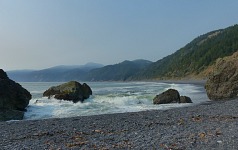 |
| From Black Sand Beach, one can see the smoky ceiling over distant hills. |
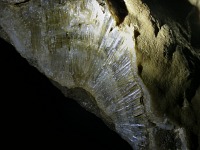 |
| Quartz. |
Given Lisa's vaulting, our family vacation got pushed into the second half of
August, which seemed to us as a good time for a second attempt with Glacier
National Park, MT. Three years ago, during our June attempt, we were beleaguered
by snow throughout. A park situated on the border with Canada was still not
ploughed by that time.
As the deadline of our this year's departure approached, another complication
emerged. Wildfires erupted around Redding, CA, and we were forced to scratch
Lassen National Volcanic Park off our itinerary. On the day before we set out,
people were being evacuated from fires near Shady Cove, Oregon, where we had
planned to raft, and subsequently visit Crater Lake. A webcam with a label
"view of Wizard Island" presented a homogeneous gray. We sighed and
decided to pretty much simply drive through northern California and southern
Oregon, and to concentrate activities to Columbia River.
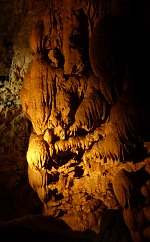 |
| A stone octopus. |
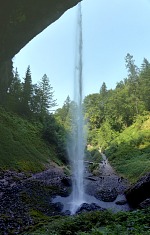 |
| Latourell Fall. |
The fastest freeway, Interstate 5, was said to be immersed in smoke, with
evacuations and wildfires around Redding, and thus we drove along the coast,
hoping that we would avoid smoke there. To interrupt our all-day sitting in
a car, we diverted to Black Sand Beach. This beach, made of pebbles, it truly
dark, and stretches for many miles — one can do a multi-day hike along
the coast there. We stopped only to stretch and breathe a little bit —
even so, over the coastal hills loomed a nasty brownish cover of smoke. We
reached Arcata by sunset, enjoying its fresh oceanic breeze. Kids declared that
it smelled there like in Czechia — indeed: moist cold air reminded of the
Czech autumn atmosphere.
Having had breakfast, we crossed from California to Oregon and took another
detour, this time to Oregon Caves. Being used to our semi-desert conditions,
the smoke cover and empty narrow roads and turn offs to tourist attractions
gave us a feeling of a post-apocalyptic scene. We even hesitated a few times
whether being on the right route — not a soul in sight, although
theoretically this was a popular area in the peak of tourist season.
Yet we were on the right patch and in time reached the cave's parking lot.
Walking four hundred yards from the car to the cave was surprisingly taxing
— me and Lisa had hard time breathing in the smoke. Marble caves were very
refreshing — not only were we finally feeling like on a vacation break,
doing something interesting, but also the cool clean underground air felt
wonderful. We discovered an old lodge at the mouth of the cave, with creek
streaming through the lobby interior, and a Cafe set in the 50's style, nothing
was lacking of our true holiday feeling. A waiter brimming with a charm of the
golden times of Americana, and besides coffee we tried various ice cream malts,
letting him talk us into fudge of marionberry (Oregon's blackberry-like fruit).
Alas, the hotel is planned to close for two consecutive years for remodeling,
and we are forced to postpone our next visit until then.
 |
| Distant smoke threatens even the Columbia River Gorge. |
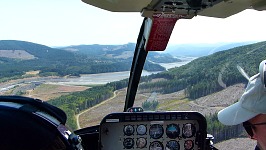 |
| A view from the helicopter. |
We did overnight in Eugene, OR, and finished the last stretch to Portland in the
morning — smoothly switching into a loop through the local waterfalls.
We prefer those near Crater Lake, for they aren't as horribly overcrowded, but
they were off limits this time. From the surrounding volcanic cliffs, a number
of brooks and creeks flow into Columbia River, but the place is so popular that
Multnomah Falls access road is closed, and one is forced to park away, taking
a shuttle bus. We gave up on that on account of being too complicated, and drove
to the more accessible lesser falls. Latourell, which falls over amazing basalt
"organ pipes", and Bridal Veil, which offers at least a little hike to
stretch one's legs. Brave individual were diving from a rock into a pool under
Bridal Veil — in the horrible muggy air, it must have been refreshing, but
we have opted for a milder form of cooling off — having meekly splashed
our feet in the creek.
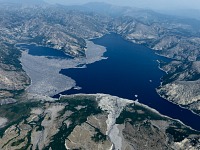 |
| Dead tree trunks still litter the surface of Spirit Lake. |
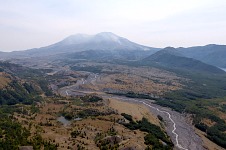 |
| Mt. St. Helens and Touttle River. |
We found a nearby Vietnamese restaurant to have soup for dinner, and on the next
day we crossed Columbia River into Washington state, to see the famous volcano
Mt. St. Helens. Eight years earlier, it was our last volcano of our volcanic
summer break, for our then four-year old Lisa started drawing pictures of dead
people, and we had switched to more cheerful attractions. Sid again longed to
fly on a helicopter, and talked us into it eventually. I hate to fly; when I
don't wear a harness and a rope, heights make me feel sick, and I did not feel
like going. On the other hand, one can best see a giant volcano from a bird's
view. We had to look for the heliport, which had moved from a convenient spot
on a cliff over Touttle River farther away from the volcano, into a nondescript
canyon, right next to a cabin immersed into the layers of ash up to its roof.
The pilot was buffing his machine and admitted to be free and ready to load us
on.
 |
| A new lava dome is rising in the crater. |
 |
| Offspring on the helicopter. |
This time the fortunate person to fly next to the pilot was Lisa. Last time she
sat between me and Sid in the rear, probably did not see much, and deserved
a better spot. I ended up in the middle. We paid for a longer flight, fully
circumnavigating the crater, which was pricier, but also much more interesting.
It has been almost fifty years since the last eruption, but what surprised us
was how much nature has advanced even during the eight years since our previous
visit. Everything has grown higher and greener, elk and other animals move
through the woods.
After the flight, we ate lunch on a patio of a local restaurant, and then drove
up to an observatory on a cliff facing the volcano — and it was time to
return across the river to our hotel. Our next day's plan was to drive through
the Columbia Gorge, stop for an outing on a paddle steam boat, and at the
Bonneville Dam. When we parked at the locks where the boat docked, the weather
seemed cold and about to rain; the steam boat seemed tiny and filled with
tourists, and besides, the ride appeared to make a loop on a wide river, without
passing through the locks or anything else impressive. Thus we only took
a picture of the pathetic vessel, and headed to the dam. Another disappointment
ensued there: at this time of year, few fish pass through the dam, and the fish
ladders were more or less empty. But perhaps we were only overwhelmed by the
strong experience with the helicopter flight on the previous day.
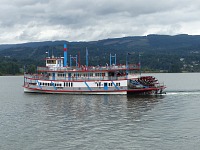 |
| In the end we only took a picture of the little steam boat. |
 |
| River lock. |
When already driving away from the dam, we noticed barges clustered in the lock,
and so we stopped and watched one downstream cycle. Level difference before and
after the dam is over sixty feet, and to open the lower gate, a road bridge must
swing aside, so there's much to observe.
Driving to the east, we passed a prairie wildfire, including helicopters
quenching it — and then only endless grassy plains, all the way to a town
named Ritzville, which contains about three gas stations, three hotels, two
pubs, and then only a small cluster of semi-decrepit houses. Local Best Western
impressed me, though, being furnished in Wild West style bordering on kitsch
— including an old wood stove dominating the breakfast room, and period
photographs arranged on a cabinet from a formal sitting room.
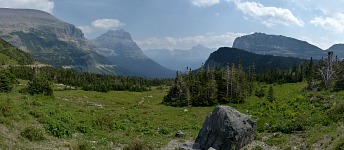 |
| Logan Pass — a view to eastern Glacier. |
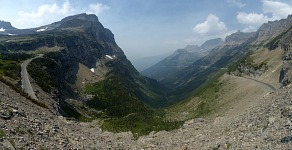 |
| Logan Pass — a view to western (smoky) Glacier. |
On the following day, a Sunday, we drove on and on, to traverse much of the
state of Washington, a narrow neck of Idaho, and reach Kalispell in Montana,
a town just next to the Glacier National Park. After a long ride, we appreciated
beer at Tamarack Brewing Company. We had discovered this brewery three years
earlier, and its popularity had apparently not diminished — by five thirty
in the afternoon, it was so full one had to wait for a table to become
available. It was only a short drive to our hotel, where we tried to see whether
we could reserve next night as well, but we did not succeed. It seems that
finding a decent hotel in a popular area is a problem. Every smelly dump asks
outrageous prices. We reckoned that one night counts, and went to bed. Having
breakfast in the morning, we watched upset tourists teeming around tables. Only
Sid had enough awareness to inquire into the reason of the upset — and
discovered that overnight, a wildfire had erupted at Glacier, and the one main
road through the park, famous
Going to the Sun Road, was closed.
This road is practically the only way to reach the park proper, and it is the
one which had been closed to us for snow, three years earlier.
 |
| Part of the trail is blasted into the rock. |
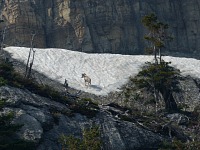 |
| Bighorn sheep. |
It totally ruined us — so many days on the road, and our fabulous
destination slips out of reach before our very eyes. Eventually we decided that,
since we made it to Montana, we would drive around the park and enter it from
the eastern side, so far unaffected by the fires. Of course, everybody else and
their uncle had exactly the same idea, and thus we suffered many hours in
traffic jams. Summer is the best time to fix roads in Montana, hence besides
regular traffic of confused tourists and shapeless hulks of huge buses, we had
enjoyed many additional restrictions and closures, one way lanes slowly sifting
motorized crowds across dusty construction sites, and similar joys.
We had entered the park literally having been driven crazy.
Parking in Logan pass was a challenge of patience — eventually we let the
Hippo circle the tiny lot and rubber-neck for a party leaving, while me and the
kids had gone to bathrooms and — to the souvenirs' shop.
Lisa had applied a targeted campaign for a stuffed mountain goat, and after all,
goats hold a place of honor in our family. We had hoped that we'd meet these
beautiful white denizens of the mountains in the flesh, but no luck this time
— and thus Shasta was the only mountain goat we had seen on this trip.
Which kind of reminded us of our trip to Colorado, where we have not spotted
bighorn sheep, besides Lisa's stuffed Sierra.
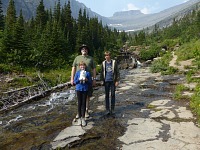 |
| The only mountain goat was spotted near Lunch Creek. |
Once Sid finally managed to park, we packed for a hike — a practically
level trail leads west from Logan Pass, with view of the canyon below. First
part was fun, we even saw bighorn sheep, but around noon, smoke began rising
from the western valley, which caused trouble breathing for me and Lisa, and we
had to turn back. We stopped once more on the eastern side, but even there the
smoke had passed now through and mercilessly rolled toward us, and we ended
the trip there. We still had much driving to do to Kalispell, where we had
reserved a hotel room.
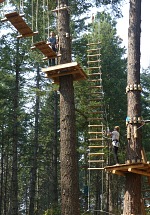 |
| Extensive aerial adventure center Tree to Tree in Idaho. |
The Fairbridge Inn and Convention Center bears a pompous name, yet it had likely
peaked in the seventies — and since them, no improvements had been made.
I sort of expect a hotel to be equipped with things less old and tired than
myself. In the end, we were rather glad to cancel the next night (it became
clear that we would never see the national park — we were choking even
in down-town Kalispell), and so we just survived that one night.
On our way to home, we hoped to be able to stop along the way and do something
interesting. Yet smoke followed us from Montana to Idaho. There we thought, it
would not get any better, and after much Lisa's asking, we stopped at Farragut
State Park, at a Tree to Tree Aerial Adventure Center. In a grove on the shores
of Lake Pent Oreille, smog contaminating all the surrounding country was not
obvious, and it was the only attraction that we could think of. Only the
children climbed into tree-tops, and after watching them through their first few
obstacles, I was glad I did not get lured into it myself.
 |
| Smoke had accompanied us through five states. |
Their routes are very nice, clever, interspersed with zip-lines, and
challenging. After two hours, and three routes, kids were visibly tiring, yet
Tom still scrambled up to a double-black route. Lisa did not managed to overcome
the entry, which was probably a good thing — she would have hardly
mastered their toughest route with her child-like height. I was surprised how
Tom, who suffers vertigo and is scared of heights, apparently felt just fine
in the tree-tops. It may work for him like for me — I feel no fear in
my climbing harness and on a rope, but my head spins on Golden Gate Bridge.
That day, we drove all the way to Kennewick, Washington. We were pleasantly
surprised by a fortunate arrangement of hotels and restaurants on the southern
end of the city, where we were not forced to drive around town.
Still, news were not favorable, as problems with wildfires and smoke kept
following us during the next day on our way to Sutherlin, Oregon, and it did
not get any better back home in California. Our lunch in Shasta City felt like
in a ghost town — a beautiful cone of the huge volcano, normally looming
over the popular tourist attraction, was practically invisible, and even the
main street and restaurants and stores were abandoned. We were thus returning
home with the bitter aftertaste of sadness from destruction of huge swaths
of nature — in the company of endless smoke.























